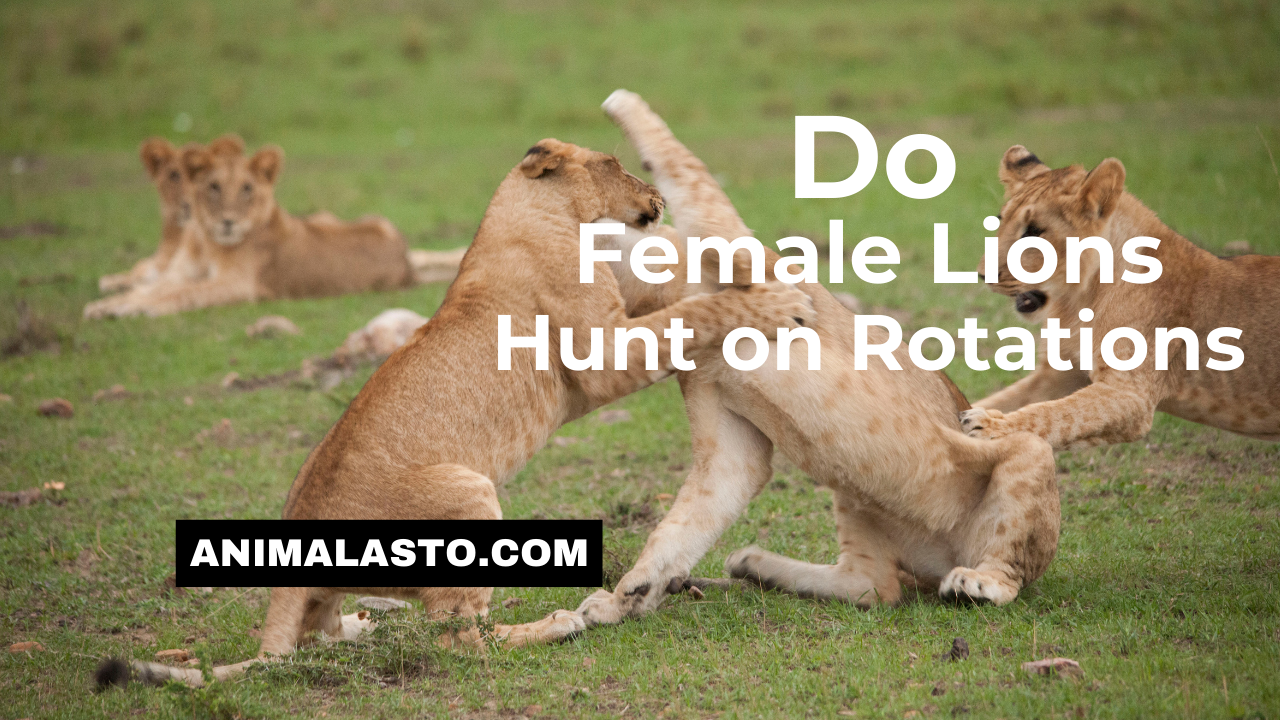Do Female Lions Hunt on Rotations? This inquiry explores one of the most interesting parts of how lions behave in groups and how they are organized socially. The hunting dynamics of lion prides include a complicated interaction of social hierarchy, survival strategies, and evolutionary adaptations that have formed over thousands of years. Female lions are the main hunters of the pride. They have developed complex hunting routines and cooperative behaviors that allow them to catch prey successfully and conserve energy over the long term. Learning about these rotating hunting patterns not only gives us a better understanding of how well lions organize themselves socially, but it also helps conservationists safeguard these majestic big animals and their ecosystems.
Contents
- 1 Basic Pride Structure and Organization
- 2 Understanding Lion Hunting Behavior
- 3 Do Female Lions Hunt on Rotations
- 4 10 Ways Female Lions Hunt on Rotations
- 4.1 1. Synchronized Rest-Hunt Cycles
- 4.2 2. Age-Based Rotation Systems
- 4.3 3. Physical Condition-Based Assignments
- 4.4 4. Weather-Dependent Rotations
- 4.5 5. Prey-Specific Team Formations
- 4.6 6. Territory Section Coverage
- 4.7 7. Night and Day Shift Systems
- 4.8 8. Seasonal Rotation Adjustments
- 4.9 9. Expertise-Based Team Formation
- 4.10 10. Cub-Care Integration
- 5 Hunting Techniques and Strategies
- 6 Impact of Environmental Factors
- 7 Pride Dynamics and Social Structure
- 8 Training and Skill Development
- 9 Conservation Implications
- 10 Frequently Asked Questions
- 10.0.1 How do female lions hunt?
- 10.0.2 What role do females play in the pride?
- 10.0.3 Why do female lions roll over after mating?
- 10.0.4 Which gender of lion is stronger?
- 10.0.5 How many lionesses typically hunt together?
- 10.0.6 Do male lions ever participate in hunting rotations?
- 10.0.7 How often do hunting rotations change?
- 10.0.8 What happens if a lioness is injured during a hunt?
- 10.0.9 How do cubs learn their place in hunting rotations?
- 11 Conclusion
Basic Pride Structure and Organization
Pride Composition
A typical lion pride consists of 2-40 individuals, though the average size ranges between 10-15 members. The core group comprises related adult females, their dependent offspring, and a coalition of adult males (typically 2-3) who maintain territorial control. This social structure is unique among big cats, making lions the only truly social feline species.
Role Distribution
Within the pride, each member has specific roles that contribute to the group’s survival:
| Role | Primary Responsibilities | Secondary Responsibilities |
|---|---|---|
| Adult Females | Hunting, cub rearing | Territory defense |
| Adult Males | Territory defense | Occasional hunting |
| Sub-adult Females | Learning hunting skills | Assisting with cubs |
| Sub-adult Males | Learning territorial behavior | Participating in hunts |
| Cubs | Learning social skills | Observing hunting behavior |
Territory Management
Depending on the availability of prey and the kind of environment, lion prides maintain territories that range from 20 to 400 square kilometers. Female lions usually inherit the territory of their birth pride, but male lions are required to leave and create new territories for themselves.
Understanding Lion Hunting Behavior
Basic Hunting Statistics
Research from various African ecosystems reveals compelling data about lion hunting patterns:
| Aspect | Statistical Data |
|---|---|
| Success Rate | 25-30% for single hunter |
| Group Success Rate | 30-40% |
| Average Hunting Time | 2-5 hours |
| Peak Hunting Hours | Dawn and dusk |
| Monthly Kills Needed | 10-15 large prey items |
Energy Conservation
Lions have evolved to maximize energy efficiency in their hunting strategies:
- Rest for 20-21 hours daily
- Hunt during cooler hours
- Share hunting responsibilities among pride members
- Utilize ambush tactics over chase hunting
Do Female Lions Hunt on Rotations
The concept of rotational hunting among female lions represents one of nature’s most sophisticated cooperative hunting systems. This section explores the evidence supporting the existence of hunting rotations and their evolutionary significance.
Scientific Evidence
Recent studies using GPS collars and behavioral observations have confirmed that female lions indeed hunt on rotations. Research conducted in the Serengeti ecosystem shows that females typically rotate hunting duties every 2-3 days, allowing for adequate rest and recovery periods.
Evolutionary Advantages
Rotational hunting provides several key benefits:
- Energy conservation
- Risk distribution
- Skill development opportunities
- Increased pride survival rates
- Enhanced cub protection
10 Ways Female Lions Hunt on Rotations
1. Synchronized Rest-Hunt Cycles
Female lions coordinate their hunting activities through an intricate system of rest and hunt cycles. This synchronization ensures that the pride always has both active hunters and resting members ready to defend the territory or care for cubs.
2. Age-Based Rotation Systems
Older, more experienced lionesses often take lead positions in hunting rotations, while younger females learn through observation and participation in less demanding roles.
3. Physical Condition-Based Assignments
Females in peak physical condition are more frequently assigned to challenging hunts, while those recovering from injuries or nursing cubs take on lighter duties.
4. Weather-Dependent Rotations
During extreme weather conditions, hunting rotations adjust to accommodate environmental challenges, with stronger hunters taking more frequent shifts during difficult periods.
5. Prey-Specific Team Formations
Different hunting teams form based on the type of prey being targeted, with specific lionesses chosen for their expertise with particular prey species.
6. Territory Section Coverage
Hunting rotations often correspond to different sections of the pride’s territory, ensuring comprehensive coverage and optimal resource utilization.
7. Night and Day Shift Systems
Some prides maintain separate hunting teams for nocturnal and diurnal hunting, maximizing hunting opportunities throughout the 24-hour cycle.
8. Seasonal Rotation Adjustments
Hunting rotations adapt to seasonal changes in prey movements and availability, with more frequent rotations during times of abundance.
9. Expertise-Based Team Formation
Hunting teams often form based on individual expertise, with some lionesses specializing in specific hunting techniques or prey types.
10. Cub-Care Integration
Rotations account for cub-care responsibilities, ensuring that nursing mothers and cubs always have protection while other pride members hunt.
Hunting Techniques and Strategies
Cooperative Hunting Methods
Lion hunting techniques vary based on prey type and environmental conditions:
| Technique | Description | Success Rate |
|---|---|---|
| Ambush | Hidden approach and surprise attack | 40% |
| Encirclement | Surrounding prey from multiple angles | 35% |
| Drive Hunt | Pushing prey toward hidden hunters | 30% |
| Solo Stalk | Individual pursuit of smaller prey | 15% |
Role Specialization
Female lions often develop specialized roles within hunting groups:
- Stalkers
- Blockers
- Pursuers
- Ambush specialists
Impact of Environmental Factors
Seasonal Influences
Different seasons require different hunting strategies:
| Season | Primary Strategy | Challenges |
|---|---|---|
| Wet | Individual hunting | Poor visibility |
| Dry | Group hunting | Prey concentration |
| Migration | Opportunistic | Changing prey availability |
Habitat Adaptation
Lions adjust their hunting rotations based on:
- Vegetation density
- Water availability
- Prey distribution
- Temperature variations
Pride Dynamics and Social Structure
Leadership and Decision Making
Female lions exhibit complex decision-making processes in hunting:
| Aspect | Description |
|---|---|
| Leadership | Experienced females lead |
| Group Size | 2-6 hunters optimal |
| Communication | Subtle body language |
| Role Assignment | Based on experience |
Social Learning
Knowledge transfer occurs through:
- Observation
- Guided practice
- Progressive responsibility
- Mentorship
Training and Skill Development
Cub Education
Cubs begin learning hunting skills through:
- Play behavior
- Observation
- Practice hunting
- Graduated participation
Skill Progression
| Age | Skills Learned |
|---|---|
| 3-6 months | Basic stalking |
| 6-12 months | Group coordination |
| 1-2 years | Hunt participation |
| 2-3 years | Independent hunting |
Conservation Implications
Habitat Protection
Understanding hunting rotations helps in:
- Protected area design
- Corridor planning
- Resource management
- Human-wildlife conflict mitigation
Population Management
| Aspect | Conservation Impact |
|---|---|
| Pride Size | Territory requirements |
| Hunting Success | Prey population needs |
| Cub Survival | Population growth |
| Territory Size | Protected area needs |
Frequently Asked Questions
How do female lions hunt?
Female lions ambush prey in groups employing stealth and coordination. Some lionesses herded prey while others waited. Hunts take advantage of poor light at dawn or dusk. Wildebeest and zebras are their main prey.
What role do females play in the pride?
Lion prides depend on female hunters, caregivers, and defenders. Sharing nursing and protection tasks, they rear cubs together. Strong social relationships help females maintain pride stability, teach younger generations hunting skills, and assure the group’s existence through coordinated hunting and territorial defense.
Why do female lions roll over after mating?
Which gender of lion is stronger?
Lion males weigh 330-550 pounds compared to 265-395 pounds for females, making them stronger. Males have bigger skulls, muscles, and manes that protect their necks during fights. Female agility and hunting skills show various strengths.
How many lionesses typically hunt together?
Usually, 2-6 lionesses hunt together, though this number can vary based on prey size and availability.
Do male lions ever participate in hunting rotations?
While males can hunt, they rarely participate in regular hunting rotations, focusing instead on territory defense.
How often do hunting rotations change?
Rotations typically change every 2-3 days, though this can vary based on hunting success and environmental conditions.
What happens if a lioness is injured during a hunt?
Injured lionesses are temporarily removed from the hunting rotation and supported by the pride until recovery.
How do cubs learn their place in hunting rotations?
Cubs gradually learn through observation and controlled participation, usually joining rotations by age 2.
Conclusion
The rotating hunting behavior of female lions exemplifies an exceptionally complex system of cooperation found in nature. The success of the hunt and the preservation of the pride depend on this precise synchronization of duties, obligations, and times. Gaining a better grasp of these patterns does double duty: it enhances our admiration for these majestic predators and offers vital information for their protection. The importance of understanding how female lions plan their hunting operations for the survival of the species for generations to come grows in light of the growing number of threats to wildlife protection.
External Resources and References
- The Serengeti Lion Project: www.serengetilionproject.org
- African Wildlife Foundation: www.awf.org/wildlife-conservation/lion
- National Geographic Lion Research: www.nationalgeographic.com/animals/mammals/facts/african-lion
- Lion Research Center: www.lionresearchcenter.org
- IUCN Lion Conservation Strategy: www.iucn.org/lion-conservation

